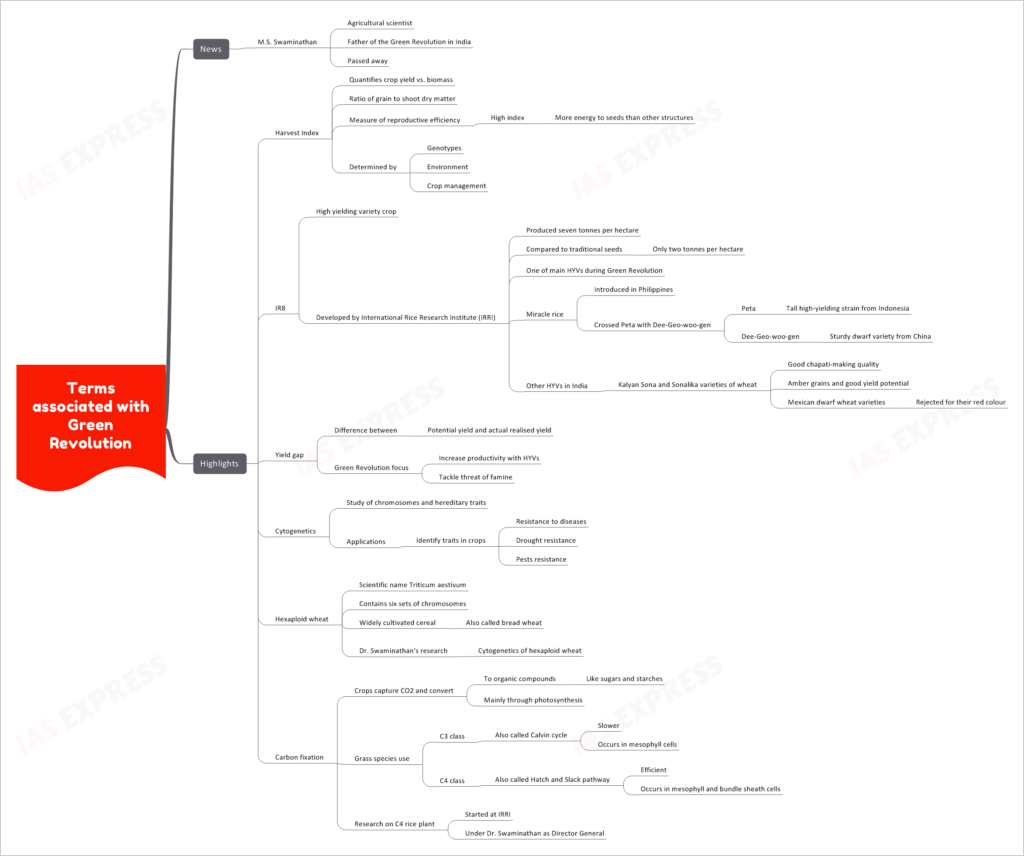Terms associated with Green Revolution

The Green Revolution, led by agricultural scientist M.S. Swaminathan, marked a transformative period in India’s agriculture and had a significant impact on global farming practices.
M.S. Swaminathan
- Agricultural Scientist: Dr. M.S. Swaminathan was a renowned agricultural scientist and a pivotal figure in the Green Revolution in India.
- Father of the Green Revolution in India: Dr. Swaminathan is often referred to as the “Father of the Green Revolution” in India.
- Passing Away: Sadly, Dr. Swaminathan recently passed away, leaving behind a profound legacy in agriculture.
Harvest Index
- Quantifies Crop Yield vs. Biomass: The harvest index is a metric that quantifies the ratio of crop yield (typically grains) to the total biomass produced by a plant.
- Ratio of Grain to Shoot Dry Matter: It represents the proportion of energy directed towards seed production compared to other plant structures.
- Measure of Reproductive Efficiency: A high harvest index indicates greater reproductive efficiency in a crop, with more energy directed towards producing seeds.
- Determined by: The harvest index is influenced by various factors, including crop genotypes, environmental conditions, and crop management practices.
IR8
- High Yielding Variety (HYV) Crop: IR8 is a high-yielding variety of rice that was developed by the International Rice Research Institute (IRRI).
- Productivity: It significantly increased rice productivity, yielding seven tonnes per hectare compared to traditional rice varieties, which produced only two tonnes per hectare.
- Miracle Rice: IR8, often referred to as “miracle rice,” was introduced in the Philippines. It was developed by crossing two strains: Peta, a tall high-yielding strain from Indonesia, and Dee-Geo-woo-gen, a sturdy dwarf variety from China.
- Other HYVs in India: The Green Revolution in India also witnessed the introduction of high-yielding varieties like Kalyan Sona and Sonalika for wheat production. These varieties exhibited good chapati-making quality, amber grains, and high yield potential. Additionally, Mexican dwarf wheat varieties were initially rejected in India due to their red color.
Yield Gap
- Difference Between: The yield gap represents the disparity between the potential yield of a crop under ideal conditions and the actual realized yield obtained by farmers.
- Green Revolution Focus: During the Green Revolution, a primary goal was to narrow the yield gap by increasing agricultural productivity through the adoption of high-yielding varieties (HYVs). This approach aimed to address the looming threat of famine.
Cytogenetics
- Study of Chromosomes and Hereditary Traits: Cytogenetics is the scientific field that focuses on the study of chromosomes and hereditary traits in organisms.
- Applications: In agriculture, cytogenetics plays a crucial role in identifying desirable traits in crops, such as resistance to diseases, drought resistance, and pest resistance.
Hexaploid Wheat
- Scientific Name: Hexaploid wheat is scientifically known as Triticum aestivum.
- Chromosome Sets: This variety of wheat contains six sets of chromosomes, making it hexaploid in nature.
- Widely Cultivated Cereal: Hexaploid wheat, often referred to as bread wheat, is one of the most widely cultivated cereal crops globally.
- Dr. Swaminathan’s Research: Dr. Swaminathan conducted significant research in the field of cytogenetics, particularly focusing on hexaploid wheat.
Carbon Fixation
- Process: Carbon fixation is the process by which crops capture carbon dioxide (CO2) from the atmosphere and convert it into organic compounds, primarily through photosynthesis.
- C3 and C4 Classes: Different types of plants use different carbon fixation pathways, such as C3 (Calvin cycle) and C4 (Hatch and Slack pathway). C4 plants, including certain crops, are known for their more efficient carbon fixation process.
- Research on C4 Rice: Research on developing C4 rice plants, which utilize a more efficient carbon fixation pathway, began at the International Rice Research Institute (IRRI) under the leadership of Dr. Swaminathan during his tenure as Director General.
International Cooperation Narrative Change
- 2021 Report: The 2021 report emphasized an unprecedented level of international cooperation in addressing global agricultural challenges. It did not specifically outline the financial barriers faced by developing countries.
- 2023 Report: The 2023 report shifted its emphasis to highlight the high cost of capital in emerging markets and developing economies, resulting in disproportionate investments in advanced economies and China.
COP 28
- 28th Conference of Parties (COP 28): COP 28 refers to the 28th meeting of the United Nations Framework Convention on Climate Change. It is scheduled to take place in Dubai, United Arab Emirates.
- Global Stocktake Report: Discussions at COP 28 will include a review of the Global Stocktake Report, influenced by findings from the 2023 IEA report. This report indicates that progress toward achieving the 1.5°C target is off track and raises concerns about climate-related developments, including the approval of the Rosebank oilfield development in the UK.
Significance
- Time Crucial: Given the upcoming COP 28 and the pressing need to address climate change and food security, the terms and concepts associated with the Green Revolution continue to be of utmost importance in the global agricultural landscape.
If you like this post, please share your feedback in the comments section below so that we will upload more posts like this.

